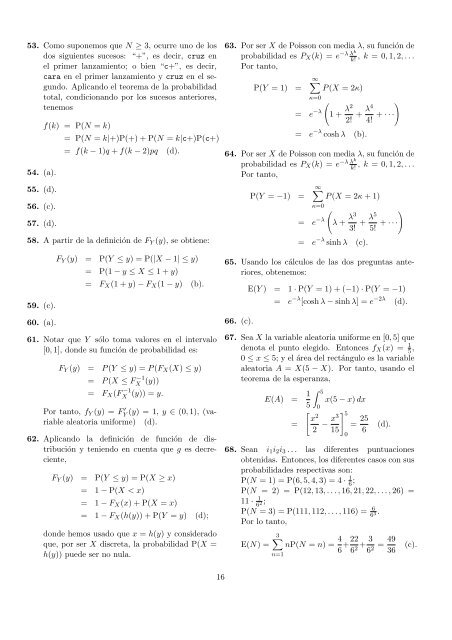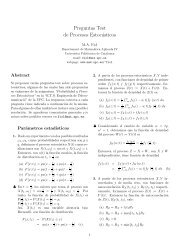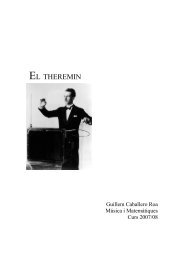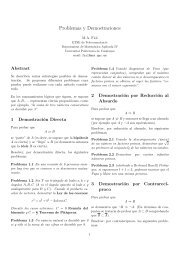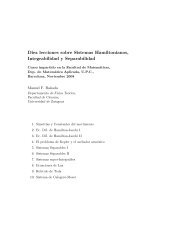100 Preguntas Test Probabilidad Combinatoria y Variables ...
100 Preguntas Test Probabilidad Combinatoria y Variables ...
100 Preguntas Test Probabilidad Combinatoria y Variables ...
- No tags were found...
You also want an ePaper? Increase the reach of your titles
YUMPU automatically turns print PDFs into web optimized ePapers that Google loves.
53. Como suponemos que N ≥ 3, ocurre uno de los<br />
dos siguientes sucesos: “+”, es decir, cruz en<br />
el primer lanzamiento; o bien “c+”, es decir,<br />
cara en el primer lanzamiento y cruz en el segundo.<br />
Aplicando el teorema de la probabilidad<br />
total, condicionando por los sucesos anteriores,<br />
tenemos<br />
54. (a).<br />
55. (d).<br />
56. (c).<br />
57. (d).<br />
f(k) = P(N = k)<br />
= P(N = k|+)P(+) + P(N = k|c+)P(c+)<br />
= f(k − 1)q + f(k − 2)pq (d).<br />
58. A partir de la definición de F Y (y), se obtiene:<br />
59. (c).<br />
60. (a).<br />
F Y (y) = P(Y ≤ y) = P(|X − 1| ≤ y)<br />
= P(1 − y ≤ X ≤ 1 + y)<br />
= F X (1 + y) − F X (1 − y) (b).<br />
61. Notar que Y sólo toma valores en el intervalo<br />
[0, 1], donde su función de probabilidad es:<br />
F Y (y) = P (Y ≤ y) = P (F X (X) ≤ y)<br />
= P (X ≤ FX −1 = F X (FX −1 (y)) = y.<br />
Por tanto, f Y (y) = F Y ′ (y) = 1, y ∈ (0, 1), (variable<br />
aleatoria uniforme) (d).<br />
62. Aplicando la definición de función de distribución<br />
y teniendo en cuenta que g es decreciente,<br />
F Y (y) = P(Y ≤ y) = P(X ≥ x)<br />
= 1 − P(X < x)<br />
= 1 − F X (x) + P(X = x)<br />
= 1 − F X (h(y)) + P(Y = y) (d);<br />
donde hemos usado que x = h(y) y considerado<br />
que, por ser X discreta, la probabilidad P(X =<br />
h(y)) puede ser no nula.<br />
63. Por ser X de Poisson con media λ, su función de<br />
probabilidad es P X (k) = e−λ λk<br />
k!<br />
, k = 0, 1, 2, . . .<br />
Por tanto,<br />
∞∑<br />
P(Y = 1) = P (X = 2κ)<br />
κ=0<br />
(<br />
·)<br />
= e −λ 1 + λ2<br />
2! + λ4<br />
4! + · ·<br />
= e −λ cosh λ (b).<br />
64. Por ser X de Poisson con media λ, su función de<br />
probabilidad es P X (k) = e−λ λk<br />
k!<br />
, k = 0, 1, 2, . . .<br />
Por tanto,<br />
∞∑<br />
P(Y = −1) = P (X = 2κ + 1)<br />
κ=0<br />
(<br />
·)<br />
= e −λ λ + λ3<br />
3! + λ5<br />
5! + · ·<br />
= e −λ sinh λ (c).<br />
65. Usando los cálculos de las dos preguntas anteriores,<br />
obtenemos:<br />
66. (c).<br />
E(Y ) = 1 · P(Y = 1) + (−1) · P(Y = −1)<br />
= e −λ [cosh λ − sinh λ] = e −2λ (d).<br />
67. Sea X la variable aleatoria uniforme en [0, 5] que<br />
denota el punto elegido. Entonces f X (x) = 1 5 ,<br />
0 ≤ x ≤ 5; y el área del rectángulo es la variable<br />
aleatoria A = X(5 − X). Por tanto, usando el<br />
teorema de la esperanza,<br />
∫ 5<br />
E(A) = 1 x(5 − x) dx<br />
5 0<br />
[<br />
x<br />
2<br />
=<br />
2 − x3<br />
= 25 15 6<br />
] 5<br />
0<br />
(d).<br />
68. Sean i 1 i 2 i 3 . . . las diferentes puntuaciones<br />
obtenidas. Entonces, los diferentes casos con sus<br />
probabilidades respectivas son:<br />
P(N = 1) = P(6, 5, 4, 3) = 4 · 1<br />
6 ;<br />
P(N = 2) = P(12, 13, . . . , 16, 21, 22, . . . , 26) =<br />
11 · 1<br />
6 2 ;<br />
P(N = 3) = P(111, 112, . . . , 116) = 6 6 3 .<br />
Por lo tanto,<br />
E(N) =<br />
3∑<br />
n=1<br />
nP(N = n) = 4 6 +22 6 2 + 3 6 2 = 49<br />
36<br />
(c).<br />
16


